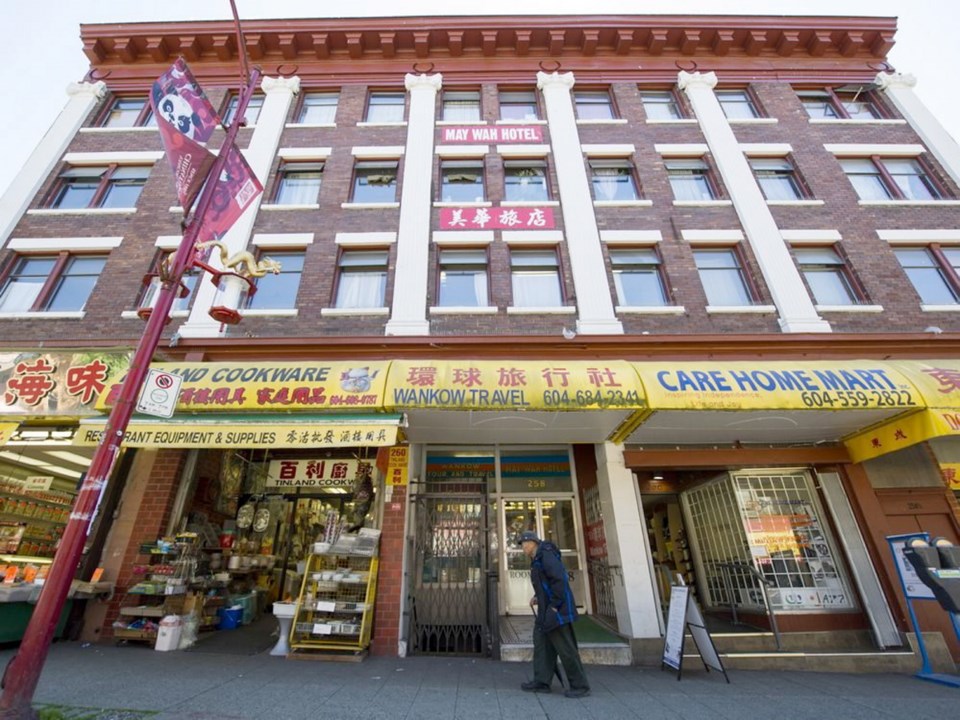The May Wah Hotel is one of the biggest and most impressive buildings in Chinatown, a four-storey brick structure with “monumental” white pilaster columns on the exterior.
But it’s the interior that’s really special. The May Wah has long been a favourite residence for Chinese seniors, one of the last remnants of old Chinatown. The clatter of mah-jong tiles and the animated patter of the residents probably sounds the same as it did during Chinatown’s heyday in the 1940s, ‘50s and ‘60s. It’s living heritage, as opposed to a photo.
The single-room-occupancy hotel has been owned by the Shon Yee Benevolent Association since 1926, and the benevolent association has lived up to its name, sometimes charging less than welfare rates for rooms.
But many members of the association are getting old, and real estate agent Erik Kwok said they want to hand it to a “new generation.” So last week, it put the 120-room hotel up for sale, for $9.99 million.
Kwok said there’s been a lot of interest.
“It’s actually quite surprising, we had a lot of response,” said Kwok, who works for Royal Pacific Realty.
“Yesterday we had six Realtors bringing clients to look into it. They were very interested — there were six agents, about 15 guys walking around the hotel.”
Located at 260 East Pender, the May Wah is a Heritage B building and is in a national and provincial historic district. This would make it hard to redevelop, particularly since the city might charge a would-be developer $125,000 a unit to convert the rooms to another use.
But some SRO owners have been able to evict the tenants, renovate their buildings and charge higher rates when they reopen, which worries Chinatown activist King-Mong Chan of the Carnegie Community Action Project.
“One of our major concerns is gentrification and displacement,” said Chan. “In Chinatown it’s been most evident in the businesses and the changing retail mix in the area. But in this instance, it’s residents living in threat of displacement.
“It’s the largest SRO in Chinatown, and also has the largest concentration of Chinese residents in a single building. Even though not all 120 units are occupied by people who identify as Chinese, I think the sense of community is still strong.”
Chinatown historian Jim Wong-Chu said the May Wah harks back to the days of Chinatown’s Bachelor Society, when single men lived and worked in Chinatown. Most were bachelors, because Canada banned Chinese immigration between 1923 and 1947 and there were few Chinese women in Vancouver.
“It’s one of the last Chinese-specific rooming houses of that size and scale,” said Wong-Chu.
“It goes way back to the early days when it was (called) the Loyal Hotel. The unique thing about it was whoever was caretaking (there) were very cognizant of the people they have there.
“So on the first level it was people who were elderly, who needed a lot more care. Usually the second floor was people that were more able bodied, and the third was more singles or working people.
“From my recollection there was always a buddy system. They would knock on the doors and ensure that the elderly were OK and so on. There was very much a community there.”
There is a difference between the May Wah today and in the past — now many of its residents are women.
“There were more widows, they were the ones that ended up (there),” said Wong-Chu. “I recall them going out every morning in a group and going to local parks to do callisthenics.”
The hotel was designed by architect William Frederick Gardiner in 1913, and stretches over three lots. The Loyal was renamed the New Orient in 1947, the Le-Kiu in 1950, the Garden in 1956, the Sydney in 1969 and finally the May Wah in 1980.
There are five storefronts on the main floor and three storeys of single room occupancy rooms above.
Surprisingly, Realtor Kwok said the people who have toured the building with an eye to buying it were all local, and white.
“I think Chinatown is being overtaken by white people,” he said.
“I think there’s a trend of more white people coming in, and more Chinese people moving out. You see more of those fusion kind of restaurants, coffee shops. In the last few years you’ve seen 10, 15 of them. Some (of those) shops were vacant for years, nobody rented them.”
He doesn’t expect to get much offshore interest in the property, because of the complexity of doing anything there.
“I think offshore money wants something different,” he said. “This deal you have to deal with the government, so nobody wants it. It’s going to be tricky.”



